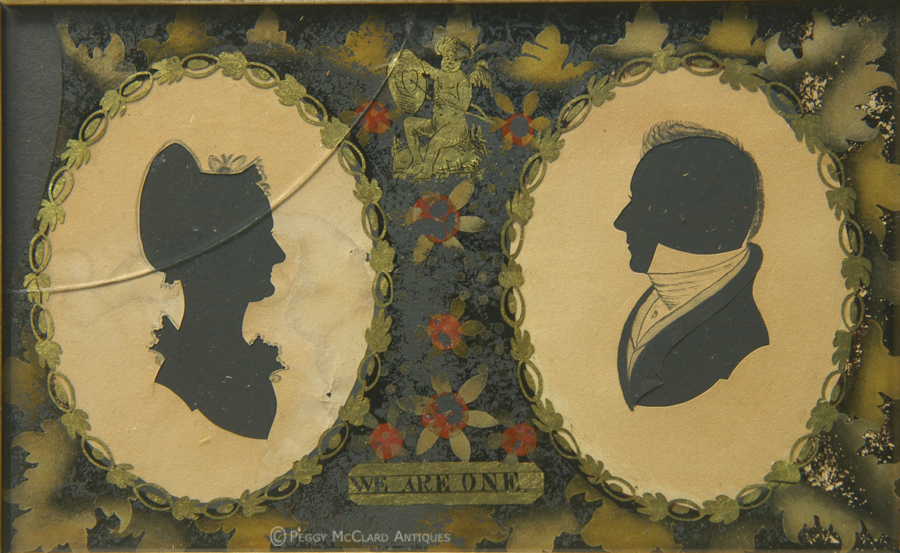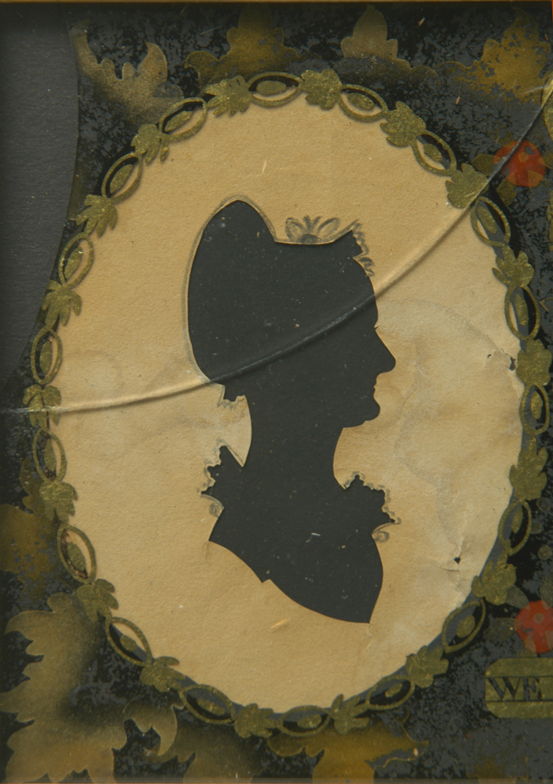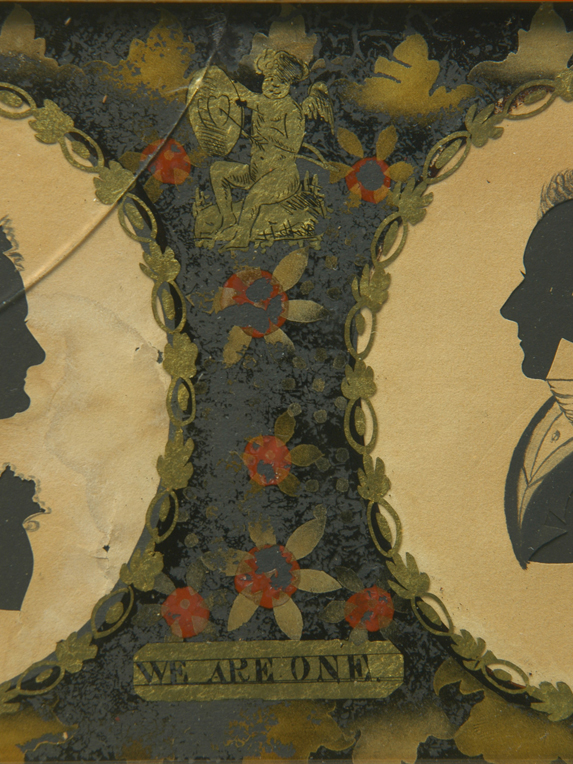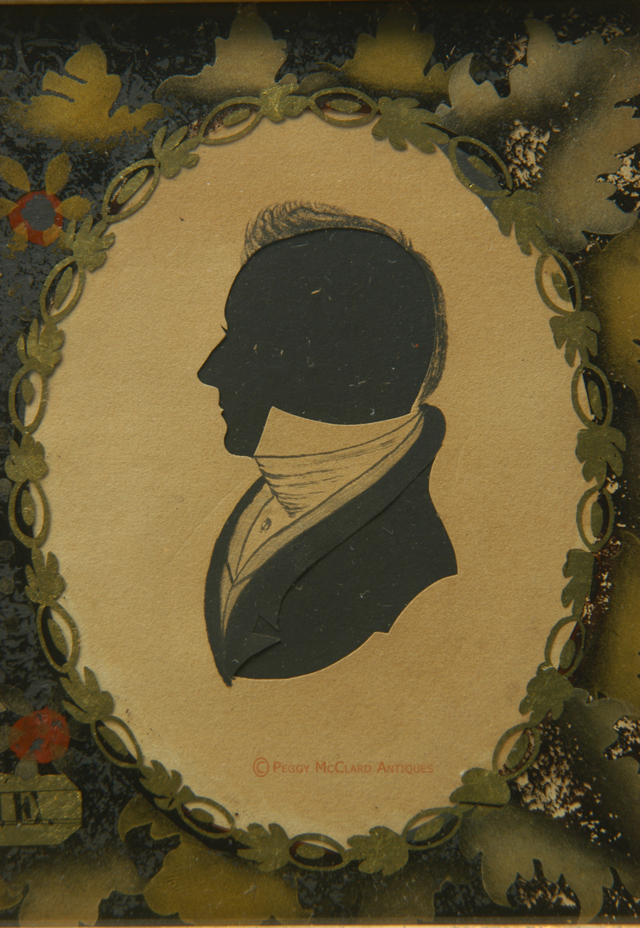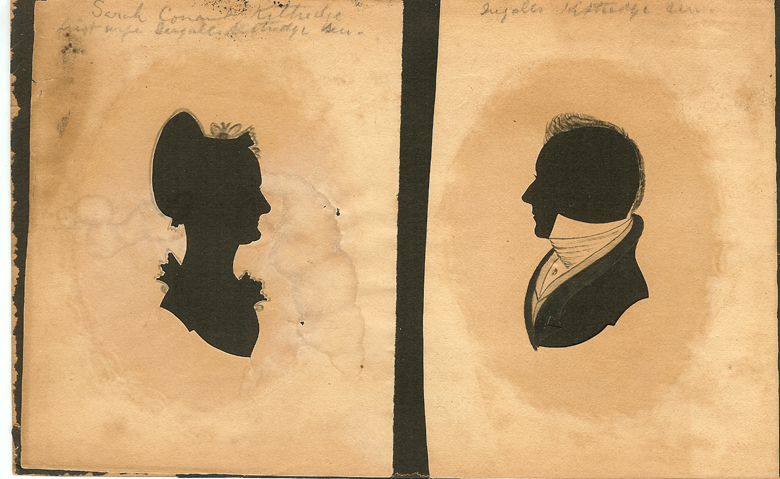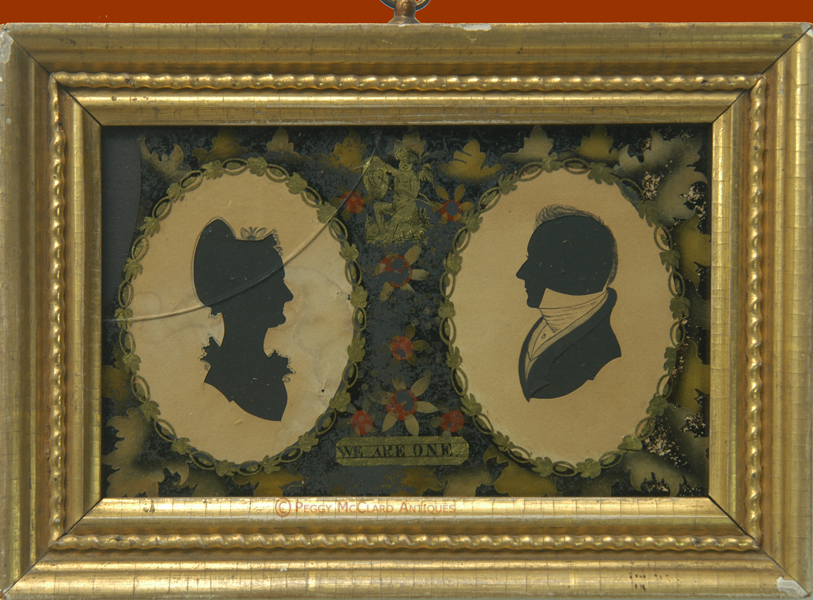
This is an amazing American hollow cut marriage pair of silhouettes attributed to William Chamberlain and set behind a stunning original verre églomisé glass mat with leaf & floral decoration as well as a gold leafed cherub (with bow and heart through which he has pierced an arrow) and "WE ARE ONE" also done in the reverse painting. These highly decorated églomisé mats are extremely hard to find these days....all have been snapped up into private collections and museums. The glass is cracked and has a piece missing in the upper left corner, but the decoration is so rare that I wouldn't think of changing it. The previous owner placed another piece of glass in front of the églomisé which stabilizes the crack (which also seems to have been glued together from behind).
For decades, people have attributed every hollow cut man with an uncut lapel and shirt front to Chamberlain, but most of those attributions are wrong. Chamberlain never signed his silhouettes. The only group of silhouettes that we know were done by Chamberlain are in a duplicate book of eighty-nine silhouettes which he kept for himself. His grand-daughter, Mrs. Frederick McClure of Worcester, Massachusetts, gave the duplicate book to the American Antiquarian Society ("AAS"). The AAS photocopied the entire book for me and an examination shows that every one of the silhouettes in the duplicate book have the same bust-line termination that you see in this pair of silhouettes. While Chamberlain may have used more bust-line termination, we can only attribute to him those silhouettes that have the one confirmed bust-line as well as his other characteristics such as the long swan-like neck seen on this woman, the pencil embellishment around the woman's collar ruff and the well-drawn shirt front, vest, stock and collar on the man. As is usual for Chamberlain, the man's hair embellishment is done in watercolor or ink while the woman's is pencil. Chamberlain cut a small perfect eyelash for each and even depicted the woman's slight double chin.
A pencil inscription written on the top of each silhouette (hidden behind the églomisé identifies this pair as Ingalls Kittredge and his first wife Sarah Conant. Ingalls was born in Amherst, New Hampshire in 1769 and died in Beverly, Massachusetts in 1856. Sarah Conant was born in Beverly, Massachusetts in 1770 and died there in 1833. Ingalls and Sarah married in 1797 and had two children, Ingalls, Jr. (1798-1867) and Sarah (1800-1835). Although the notation on the silhouette says that Sarah was the first wife, the extensive genealogical information I have found does not show that Ingalls ever remarried. Ingalls family came to America from England around the mid-17th century. His family line leads back to the names Kittredge, French, Holt, Farnum, Ingalls, Phillips, Gilbert, Emery, Littlefield, Hill, Olmstead, Godfrey, Oliver and Burridge. If your family came from England to Massachusetts in the 17th century, you are likely related to Mr. Kittredge. I've only been able to trace Sarah back to her grandparents. She was the child of Jonathan Conant and Mercy Lovett. Her paternal and maternal grandmothers were both from the Woodbury family (likely sisters). The folder of genealogy information I have on this couple is huge and will be included with the silhouettes as a spiral bound booklet.
As far as I can tell, the stunning gilt frame with a ripple cove is original to the silhouettes. The frame, which measures 9 7/8" x 7", has very few insignificant knocks, one in each corner and at the top edge just to the right of the brass hanging loop. The woman's silhouette has suffered some water damage (see the scan of the silhouettes unframed). The stains are not terribly noticeable when viewed through the double layer of glass. As the scan shows, both silhouettes have darkened from the light and you can clearly see where they have sat behind the églomisé for almost two centuries. To me, the apologies are insignificant because of the beauty & rarity of the églomisé, the fact that these really are by Chamberlain and represent his style beautifully, and the extensive family history of the sitters. This is a great overall package of American folk silhouettes. Circa 1820.
(#4662) Sale Pending
Provenance: ex-Fred J. Funk, Jr. of Illinois
Please see the Silhouettist Bios page for more information about William Chamberlain.

